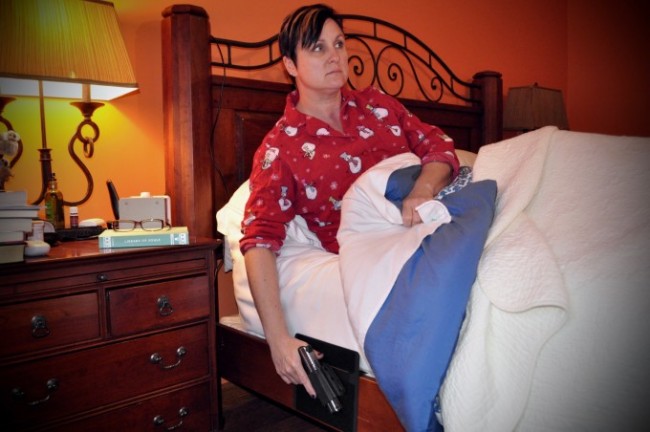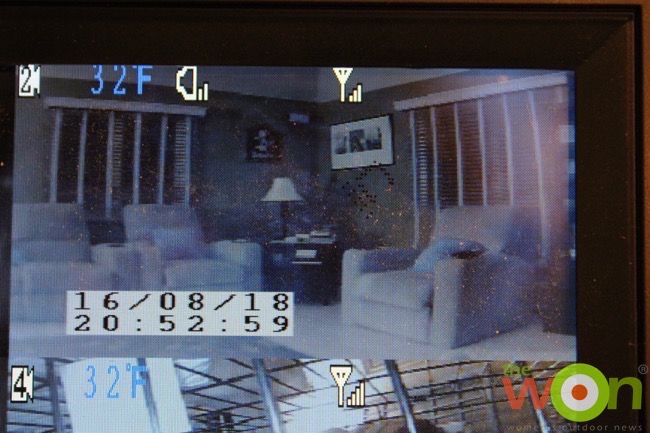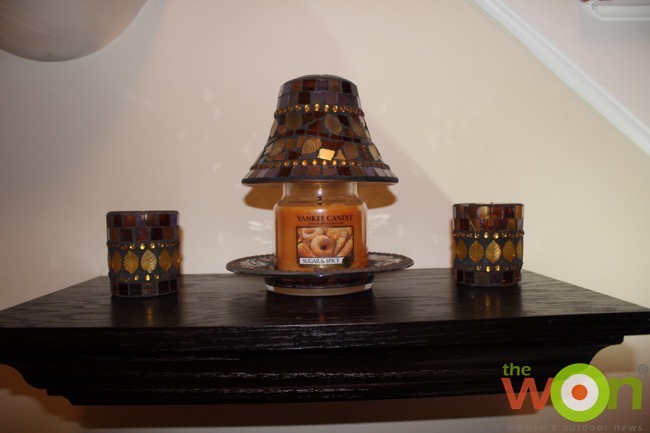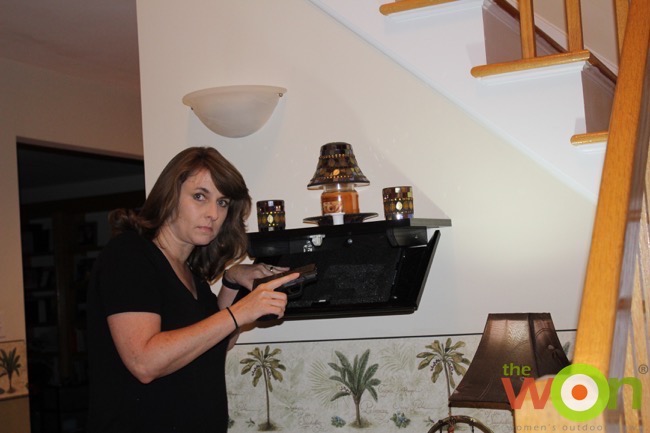By Annette Doerr, Women’s Outdoor News
Thump. Crash! You awaken from a sound sleep, but you’re not sure why. You listen for a few seconds, groggily trying to process what’s going on. Then you realize what’s happening; Someone is in your home. Do you have a plan? If you don’t, let’s start that conversation right now.
My dad was the local fire chief, and growing up we always had an escape plan should there be a fire in our home. It’s something that I, in turn, drilled into my daughters as soon as they were old enough to understand. Even as they went off to college, they had a plan should something happen in their dorm. Fire is something people understand and often plan for, but a home invasion? Not so much.
My colleague Stacy Bright recently wrote a great piece on making your home a hard target. But what happens if that’s not enough? What if, in the middle of the night, you hear glass break? You awake from a dead sleep trying to process what you just heard. Did the cat knock over something? Did the dog bump into a chair in his quest to get a drink? Is there someone in my house? It’s a scary thought, isn’t it? It’s worse if you’ve never taken the time to run scenarios on what might happen should someone gain access to your home while you’re inside.

–
If someone broke into my home in the middle of the night, chances are I’d be asleep in my bedroom. The layout of my house is atypical. My bedroom sits in the back of the house, down a long hallway. There is no egress from my room other than a spiral staircase to the office upstairs. Because of the layout, and the fact that we have casement windows, making a plan ahead of time is a necessity. My husband and I each keep a pistol in our nightstands; an intruder in my bedroom would likely be facing down the barrels of not 1, but 2 pistols, which would boost our odds of surviving. It’s always best to get out, but if you can’t, a little planning can improve your odds dramatically.
Burglaries and home invasions can also happen during broad daylight. Criminals assume the homeowner is at work during daytime hours, but most days, I work from home. Because of this, I’m generally carrying when I’m home. From the street it may look like the house is empty, making a daytime robbery attempt a distinct possibility. Does it make me paranoid to carry while in my own home? No, it makes me prepared.

–
Because I live in New York, I have the “duty” to retreat should someone break into my home. I can only use deadly force if I feel that my life is in danger and I cannot safely leave the premises (and even then, I’ll be judged by a jury of 12). I do not have the same ability under the law to protect my home from an intruder as say, someone in Texas. State laws vary wildly on their interpretation of the Castle Doctrine and the use of deadly force. I’d urge you to familiarize yourself with the laws of your area, so that you can make the best plan possible for you and your family.
What are some things you’ll need to work out when making your home intruder plan? Start by going from room to room and looking around. Are there 2 ways out of this room? Is there a great place to hide a weapon where it’s out of sight and appropriately safe, but quickly accessible should you need it? If you have a sketch of the layout of your home, make some notes on it. This will help you when you brief your family on the plan.

–
Here are some tips to help formulate a home intruder plan that works for you and your family:
- Secure firearms in various locations throughout your home, including your bedroom. I have a Covert Cabinet in my front foyer. Although it looks like a decorative shelf, it actually securely hides a firearm, which I can retrieve quickly and efficiently at a moment’s notice. I also have a wall gun safe hidden in my home, where we keep a pistol at all times. It’s out of sight and I can access it quickly. For some other tips on strategically placing firearms in the home, see Michelle Cerino’s article 24/7 Pistol Carry Made Easy.
- Predetermine 2 ways of exiting each room. Knowing how you can get out of a particular room in your home will help determine if you may have to stay and defend yourself.
- Are your windows casement style or double hung? If double hung, you may be able to exit through the window to safety if you’re on the first floor.
- Do you have access to the outdoors from your basement? Your best move may be down and out.
- Does each room have a telephone in it? Know where your phones are for calling 911. You may not remember to grab your cellphone.
- If your home is equipped with security cameras, you may be able to view other rooms on your cell phone. This will let you know where the intruder is at any given moment, letting you time your escape.
Now that we’ve covered some basics and you’re working on your plan, what do you do if someone breaks in?
- Call 911.
- Retrieve your firearm.
- If you can move to a safe place, do it. You don’t have to be a hero. If you can safely move yourself and your family out of harm’s way, do it. Let the police handle the perp.
- Keep in contact with the police. Let them know you’re armed. If you are still in your home, tell them where you are in the home. Try to remain on the telephone with the 911 operator, relaying information.

–
There’s been a lot of talk lately about panic rooms, sometimes called safe rooms. Safe rooms are a secret windowless room that you can evacuate to for safety. Your home may have a safe place that can be turned into a panic room if you live in an area where tornadoes or hurricanes are a threat.
If I were building a home, I might decide to incorporate one of these secret rooms into the plan, but you may also be able to retrofit an existing room into one. Safe rooms generally have a secret entrance and no windows. (Your very own Batcave, how cool!) It could be behind a movable bookshelf or under a trap door in the floor covered by a rug. However you decide to access your safe room, know how to get into it quickly and quietly.
Here are a few items you’ll want to keep in your safe room:
- Cell phone: Even an inactive cell phone can dial 911 if charged. Keep one of your old phones charged and in the room.
- Battery-operated lights, flashlights, and lanterns: You’ll want a light source should the power go out. Since panic rooms generally have no windows, it will be pitch black in there. Having a lantern will be necessary.
- Firearm: You’ll need something to defend yourself with. Keeping a firearm in your panic room will ensure that you’re ready for anything should the time come.
- Food and water: Who knows how long you’ll be inside? Food and water are great comfort items, especially if you have small children.
- Medical supplies, or a first-aid kit: You may need to provide first aid to someone in your family, so be prepared. If you’re taking prescription medications, you’ll want to have some stored inside.
- Fire extinguisher: Cover all your safety bases.
- Other: If you do have small children, you’ll want to keep some playthings inside to occupy their time. You may also want to keep extra diapers, formula, etc. in there as well, if you need them. Give some thought to what else you may need, depending on your family dynamics and the size of your room.
The more prepared you are for a home invasion, the better your chances are of making it out unscathed. Take time and formulate a plan. Share it with your family. Oftentimes others may think of something that should be added, so get everyone’s feedback to make sure your family is as prepared as you can be. It’s going to be a frightening situation regardless of how well you’ve planned, but wouldn’t you rather have an idea of what to do? Remember: You aren’t being paranoid, you’re being prepared. If you have a plan and practice it, you’ll be less likely to panic should a home invasion occur. Be prepared, and most of all, be safe.
Thanks to Women’s Outdoor News for this post. Click here to visit WomensOutdoorNews.com.
Annette Doerr’s column is sponsored by LaserMax – Click here to check out the new Spartan™Light & Laser.


